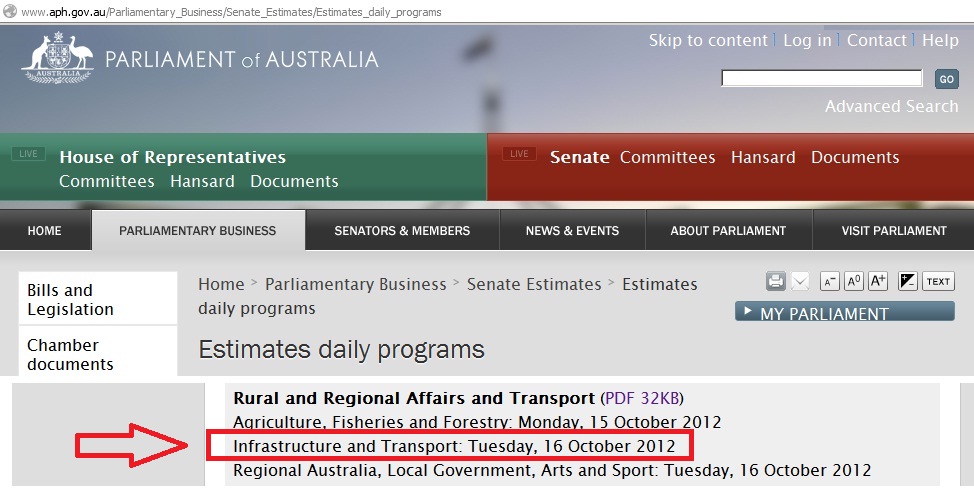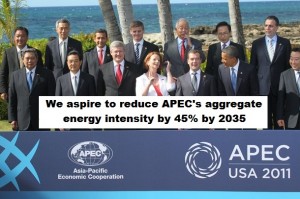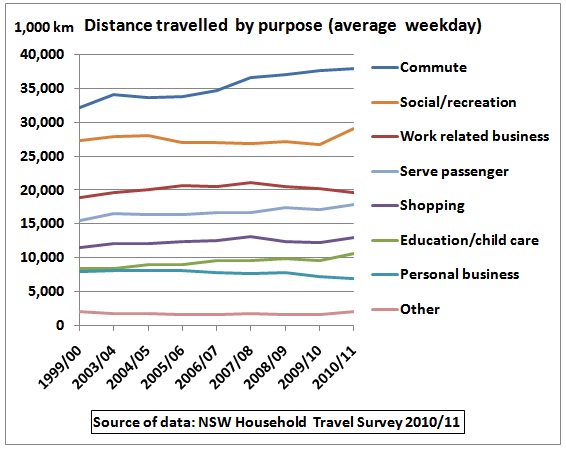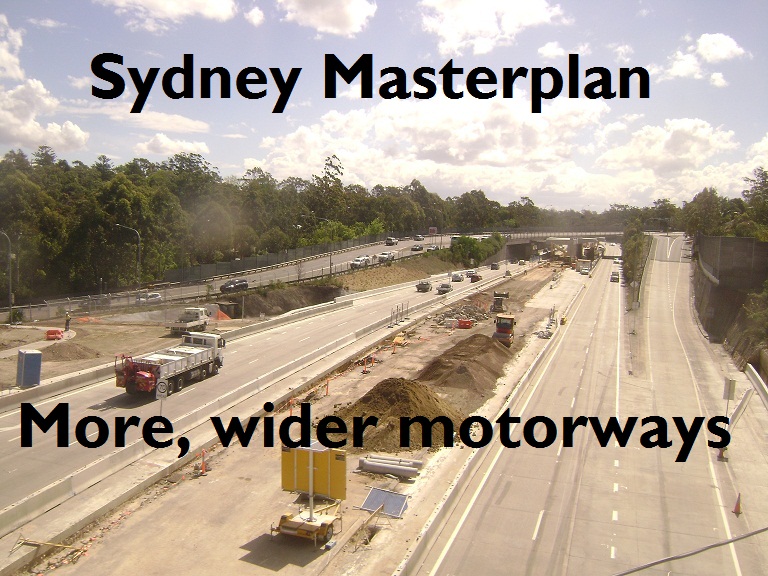In April 2009, in an energy white paper workshop in Sydney’s Crowne Plaza the participants were told not to debate peak oil but agree on an objective “Away from oil”.
3 1/2 years down the track, nothing of this can be seen in recently published documents by the Federal and NSW governments. In this article, we look at the NSW Transport Masterplan which should be about rail development and public transport but contains so many toll-way and highway projects that the question arises what the real objectives of this plan are.
But first a look at the broader picture, set by top infrastructure bureaucrats:
(1) Federal Direction
We start by looking at the transcript of a recent Senate budget estimate hearing in Canberra.
The Secretary for Infrastructure Australia ……
| Mr Mrdak: ….The reality is that if we are seeing more traffic on motorways, isn’t that a good outcome, in the sense that we are seeing more activity, more development, more economic activity? |
Obviously, the Secretary has already forgotten Australia’s “aspiration” at last year’s APEC conference to reduce energy intensity by 45% by 2035.
20/11/2011 APEC energy intensity reductions: what it means for Australian oil consumption
http://crudeoilpeak.info/apec-energy-intensity-reductions-what-it-means-for-australian-oil-consumption
I found that business as usual (GDP + 2.6% pa and oil consumption + 1.3 % pa) will only achieve an oil intensity reduction of 20% (oil intensity = oil consumption divided by GDP), mainly by growing GDP faster than oil consumption, not necessarily by reducing oil consumption. Calculations had shown that in order to achieve a 45% reduction target a very modest reduction in oil consumption of 1.6 mb pa would be needed.
Let’s have a look at how petroleum sales developed over the last 3 years:
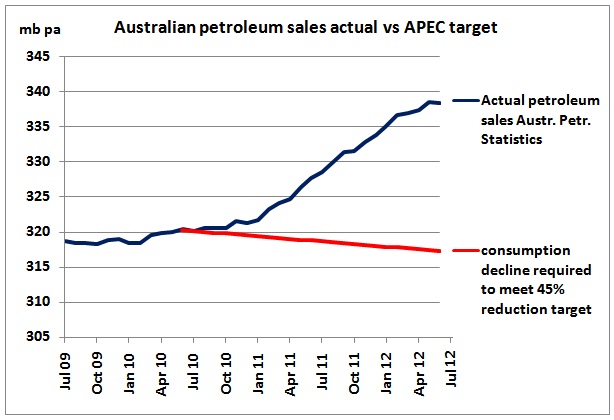 Oops, that doesn’t look good. Australia is going in the wrong direction.
Oops, that doesn’t look good. Australia is going in the wrong direction.
A similar uptick can be seen in a report of the NSW Bureau of Transport Statistics:
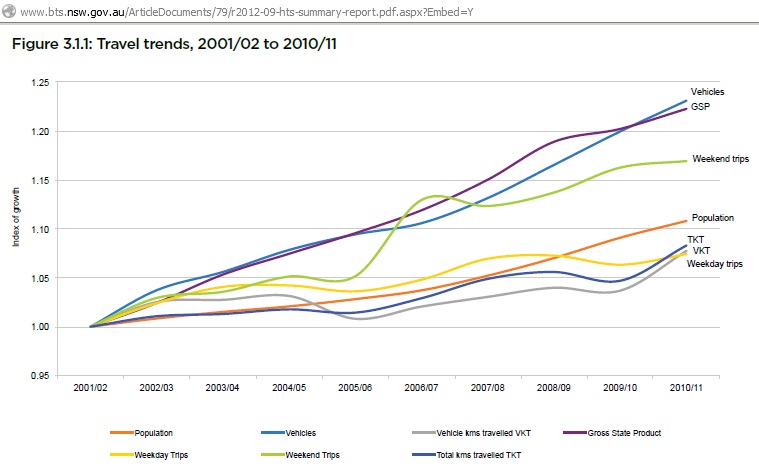 http://www.bts.nsw.gov.au/ArticleDocuments/79/r2012-09-hts-summary-report.pdf.aspx?Embed=Y
http://www.bts.nsw.gov.au/ArticleDocuments/79/r2012-09-hts-summary-report.pdf.aspx?Embed=Y
Fig 3.1.1 (up) from the 2010/11 Household Travel Survey shows the Gross State Product (GSP) going up by 2.4% pa and vehicle kms travelled (VKT) up by 0.8% pa although the latter is not evenly distributed over the years and we had periods of stagnation and even decline after 2004/05.
It is interesting to look at the different components of the annual distance travelled during average weekdays. We see:
a) The largest increase is in commuting, suggesting that cities (mainly Sydney) cannot manage to bring work places closer to residential areas
b) A recent increase in recreational traffic
c) A peaking in work related business
d) A slight increase in car pooling
e) A steady increase in trips bringing kids to school by car, reflecting increasing safety concerns of parents
It could well be that component (a) is the result of motorways built or extended in the last decade. A lot of homework to do for town and infrastructure planners.
Population growth in the last 10 years 2001-2011 was an average of 0.97 % pa but 1.4% in the last 5 years (ABS 3218.0 – Regional Population Growth, Australia, 2011 – NSW) mainly driven by overseas immigration – a topic for another article.
In any case, the upward trend in VKT is incompatible with a reduction in oil intensity.
(2) NSW (Mis-) Direction
Bizarre: in New South Wales, the Chairman of Infrastructure NSW (INSW) thought – in a Sep 2012 interview with ABC TV – that the Dec 2006 financial collapse of the Cross City Tunnel – in which he was involved as CEO of a construction company – qualifies him to oversee the planning of yet more road tunnels and toll-ways:
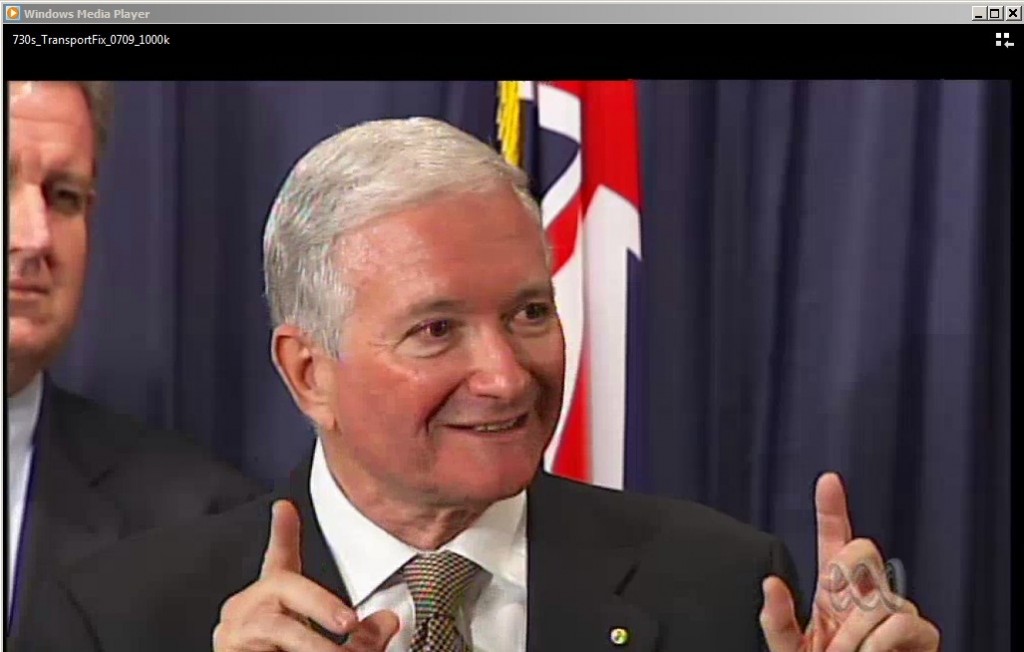 Up with those traffic estimates for road tunnels:
Up with those traffic estimates for road tunnels:
Former Premier Nick Greiner and now INSW boss
“What happened is you got a substantial gaming effect where between the banks, the engineering consultants, the traffic consultants, the construction companies, everyone tried to get their patronage estimates up and get the banks to fund these estimates, because that’s how you won , and that’s how you could pay whoever the State treasurer was lot’s of money upfront. So, yeah, it is the case that Bilfinger Berger was in that project and lost money on it. I don’t.. that’s actually a qualification, dare I say it, for my involvement in this position”
And here is the game, as already described 2 years ago:
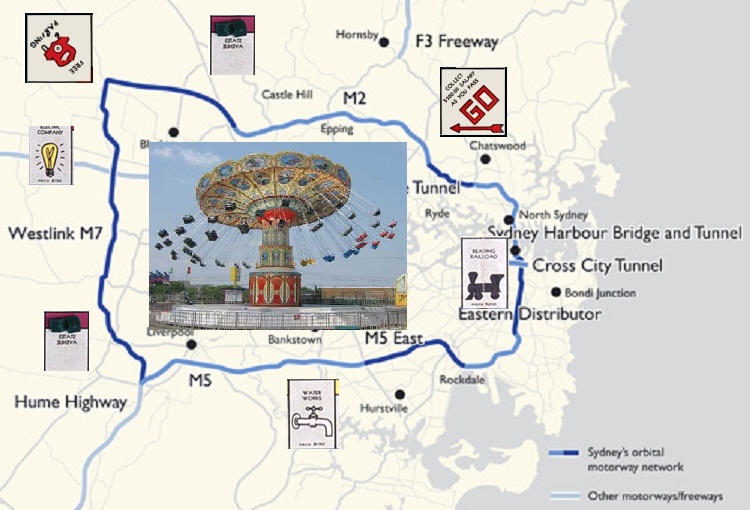 11/11/2010 Tollopoly on Sydney’s orbital
11/11/2010 Tollopoly on Sydney’s orbital
http://crudeoilpeak.info/tollopoly-on-sydney%e2%80%99s-orbital
(3) NSW Transport Masterplan 2012
Web link: http://haveyoursay.nsw.gov.au/article/draft-master-plan-released
The team working on the Masterplan has internalised the INSW bias on roads by accepting and proposing the so-called “missing motorway links” in Sydney and the continuation of highway duplication outside the Metropolitan area, instead of working on rail projects which could do the same transport job more productively and reduce oil consumption.
There are many other problems in this document. Here is a summary:
Methodology and Sequencing
The methodology is very simple: assume a linear world with unconstrained economic and population growth along past trends. The plan starts with (unquantified) objectives, continues with project proposals and then discovers three quarters into the report that sustainable sources of energies will have to be found: the sequencing of chapters is not logical. A system dynamics analysis incorporating limited oil and energy supplies, increasing debt, geopolitics in the Middle East and climate tipping points is unknown to the authors of this plan. This article is one year old:
9/11/2011 System Dynamics peak oil, financial and CO2 debt, ME geopolitics
http://crudeoilpeak.info/system-dynamics-peak-oil-financial-and-co2-debt-me-geopolitics
Objectives
All objectives in chapter 1 lack quantification and timelines. Therefore, it will be impossible to measure the performance of plan implementation. Chapter 8.3.4 mentions a target to reduce CO2 emissions by 5% by 2020 but nowhere in the plan are there any calculations if or to which extent this target can be achieved by the portfolio of projects proposed. Any savings would be cancelled out by tripling coal exports from Newcastle which the plan supports.
Proposals
The plan proposes a business-as-usual set of motorways (M5 East, M4 Extension, F3-M2 link) and inter-city highways with a couple of rail projects to service greenfield developments in Sydney’s West and to improve access to the CBD, including new projects which add new traffic. Otherwise it’s all buses. More coal trains also feature prominently.
Consistency
Given the deficiencies in the definition of objectives and the mixed bag of contradictory proposals there is no particular direction of this plan. Each chapter seems to have been written by a separate team, with a lot of duplication and repetition but without overall coordination at report level.
Omissions
What has been completely omitted: main rail line duplication and electrification, night-trains replacing domestic flights, replacing car traffic by public transport, rural branch line rehabilitation, decentralisation of urban development, transition from oil to alternative fuels (CNG and LNG) and getting away from fossil fuels in general.
Outcome
If this plan is implemented expect this to increase:
- Fuel consumption and therefore oil vulnerability at Metropolitan and State level
- CO2 emissions in NSW
- Future compensation claims resulting from coal exports
- Motorway debt and losses of super annuation funds
- Waste of budget allocations
- Bankruptcies of companies with high fuel cost
Assessment
The plan will fail as many of its predecessors. Here is a list:
“Action for Transport”, “Fast Rail” “Rail Expansion Programme”, assorted “West-, North West and CBD Metros”, “Transport Blueprint” and “Metropolitan Transport Plan”. A good summary is here: http://en.wikipedia.org/wiki/Proposed_railways_in_Sydney
Recommendation
The plan must first identify all available, sustainable sources of (primary) energy as mentioned in chapter 8.3.4. On this basis a set of quantifiable objectives must be defined. In a 3rd step transport projects must be designed to achieve the targets in a given time. The ratio of funding road/rail has to be commensurate with the objectives.
Download
A detailed critique can be found in my submission
=======
Previous posts on the same topic:
20/5/2012 Submission on NWRL
http://crudeoilpeak.info/wp-content/uploads/2011/02/Submission-on-NWRL.pdf
30/4/2012
NSW Transport Master Plan debates conventional peak oil 2006, assumes continuing oil age
http://crudeoilpeak.info/nsw-transport-master-plan-debates-conventional-oil-peak-2006-assumes-continuing-oil-age
8/3/2010 Submission to the Inquiry of the Sydney Morning Herald
http://www.crudeoilpeak.com/?p=1231
7/10/2009 Too late for Sydney Metro Tunnels
http://crudeoilpeak.info/too-late-for-metro-tunnels
8/1/2006 How Cross City Tunnel Planners ignored peak oil
http://www.crudeoilpeak.com/?p=219
